Air quality, barn temperature are two of the most critical environmental components that affect pig health and performance.
December 28, 2020
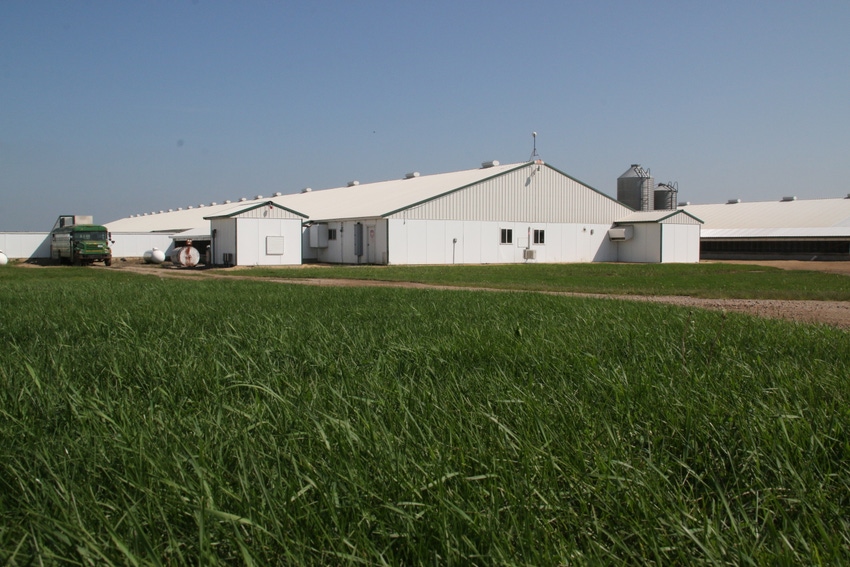
Air quality and barn temperature are two of the most critical environmental components that affect pig health and performance. Poor ventilation increases disease and reduces growth rate by creating a barn environment high in humidity and excess gasses. Many ventilation mistakes are the result of efforts to save utility costs. An understanding of some fundamental ventilation concepts will help set up a barn environment that both optimizes pig health and performance while keeping utility costs in-line.
Minimum ventilation
Minimum ventilation is the amount of fresh air needed to be brought into the barn to control humidity and gas contaminants (i.e., carbon dioxide, ammonia, etc.). Accuracy with minimum ventilation settings is crucial as over ventilating will inflate utility costs (propane and electricity) while under ventilating will produce an environment detrimental to pig health and performance.
In most barns, the fans assigned to minimum ventilation are variable speed fans which have two important settings – minimum speed and bandwidth. Minimum speed is a controller setting that signifies the speed at which the minimum ventilation fans will operate at any time room temperature is below set point. When the room temperature rises above set point, minimum ventilation fans steadily increase speed until the maximum speed is achieved. The number of degrees for variable speed fans to go from the minimum speed setting to 100% is called bandwidth. Bandwidths can be widened or narrowed based on ambient temperatures, number of fans, pig size, motor curves, or other factors that impact pig comfort.
We recommend minimum (stage 1) bandwidth settings of 1.5-2.0°F. A bandwidth setting of 1.0°F or less is too narrow for most barns and will increase fan speed too quickly, potentially chilling pigs. Wider bandwidths (above 2.0°F) reduce the ability to efficiently remove heat from the barn.
It is important to note that the setting on the controller does not necessarily equate to the percentage of maximum cubic feet per minute (CFM) output by the fan. For most variable speed fans, there is good alignment between controller setting and CFM output between 75-100%. However, the reduction in CFM output is disproportionate to the reduction in minimum speed controller setting at 70% and below (Figure 1). Most variable speed fans will produce 50% of their maximum CFM output with a minimum speed controller setting between 55-60%.
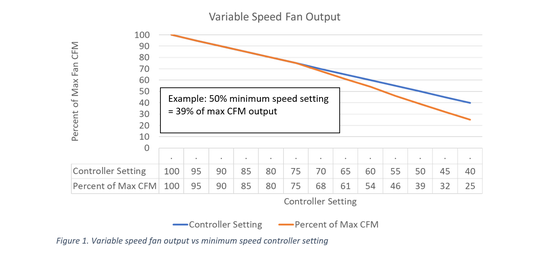
Minimum ventilation needs are calculated based on the number and size of pigs in a barn. Controller settings to achieve the needed minimum ventilation are dependent on the number and size of fans on stage 1. Take the time to calculate the minimum ventilation rate needed rather than set minimum ventilation fans at an arbitrary minimum speed. Reference charts for fan CFM output (Figure 2) and required CFMs per pig (Figure 3) are helpful for these calculations.
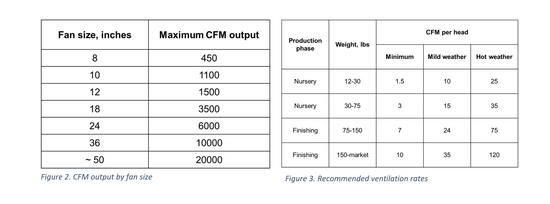
As an example, consider a 2400-head wean-to-finish barn receiving newly weaned pigs. Minimum ventilation needs are 3600 CFM (2400 pigs x 1.5 CFM/pig). If stage 1 consists of 1 x 24-inch variable speed pit fan, 60% of the maximum CFM output would be required for minimum ventilation (3600 CFM needed ÷ 6000 CFM max output x 100). Therefore, a minimum speed controller setting of approx. 65% would be needed to obtain 60% of the maximum CFM output (Figure 1).
Keep fans clean - it is essential to routinely clean exhaust fans. Even 1/8 inch of dust or dirt can reduce fan efficiency by up to 40%. This will significantly alter the minimum ventilation settings required to attain the correct barn environment.
Temperature probes
Ventilation controllers rely entirely on temperature data received from multiple probes located throughout the pig space. If probes are placed incorrectly, the controller will receive inaccurate readings resulting in incorrect controller operation and barn environment.
Recommended height and location of temperature probes varies by barn type and stage of production (Figure 4). Make sure to adjust probe height between nursery and finisher stages in wean-to-finish barns. Probes should be positioned away from ceiling inlets and heaters to avoid artificial fluctuations in temperature from cold or hot air.
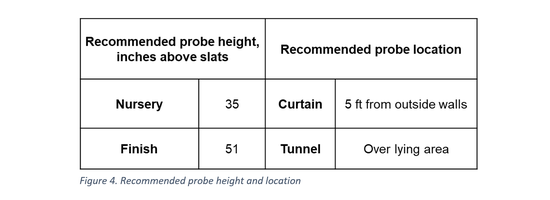
Heaters
Improperly set heaters are a surefire way to waste propane and skyrocket energy expenses. Like variable speed fans, heaters also have two primary settings to consider– offset and differential. The offset is the number of degrees below set point that the heater shuts off. Differential is the number of degrees that the heater will run. Adding the heater offset and differential together determines the number of degrees below set point that the heater will turn on. For example, with a set point of 80°F, heater offset of 2.0°F, and heater differential of 1.0°F, the heater would turn on at 77°F and run until the room temperature reached 78°F (Figure 5). Some controllers have simplified these settings to “heater on” and “heater off” temperatures.
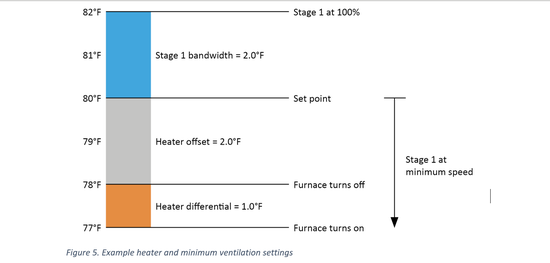
Setting heater offset and differential correctly are keys to achieving consistent room temperatures and limiting propane waste. The most common problem found in barns are furnaces that shut off too close to the setpoint temperature. In these cases, room temperature rises even after the furnace shuts off as it takes some time for the heated air to circulate and the probes to detect the increase in room temperature. If the heater is programmed to shut off too close to set point, the room temperature will rise above the set point causing minimum ventilation fans to ramp up and exhaust the heated air to cool the room – essentially blowing recently burned propane right out the exhaust fans.
A suggested heater offset of 1.5°-2.0°F and differential of 1.0°F are good starting points. Understand every barn is different based on the number and size of furnaces in a room as well as the cubic feet of room to heat. An effective way to fine tune furnace settings is to make note of the current settings and observe the room temperature as it cycles through a heater on and off run. Ideally, after the heater shuts off the room temperature should rise to just below the set point without going over. If the room temperature rises above set point, increase the heater offset so that the heater shuts off further below set point. Correct heater settings can reduce propane use by several gallons per heater per day resulting in significant energy savings.
Summary
Barn environment has a substantial impact on pig health and performance. Incorrect minimum ventilation, probe placement, and heater settings will be detrimental to both pig health and performance. Understanding and implementing these ventilation fundamentals will help maximize performance and control utility costs.
Source: Dr. Sam Holst, who is solely responsible for the information provided, and wholly owns the information. Informa Business Media and all its subsidiaries are not responsible for any of the content contained in this information asset.
You May Also Like



